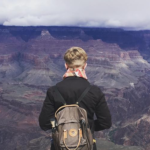The Precarious Precariat and the Garrison State

Photograph by Nathaniel St. Clair
If the Garrison State isn’t already here, it’s sure to be here very soon. Wait and watch and observe the arrival of a suped-up American political and economic system buttressed anew by the military. True, all eyes, or at least a great many of them across the US and around the world, have been focused on Washington D.C., the White House and Trump’s controversial appointees to cabinet positions.
But those eyes will soon shift to the 1,951-mile border that separates the US from Mexico and that’s said to be the busiest in the world. Millions cross it every year. Ever since Donald Trump’s arrival on the political scene, it has been one of the most hotly contested borders on the planet.
On Monday November 18, Trump confirmed that he intends to declare a national emergency and use U.S. troops to assist the mass deportations of undocumented immigrants. Sounds like neo-fascism to me. Immigrants are the scapegoats, the persecuted and members of the precariat.
Of course, the border along the Rio Grande has been a political hot spot ever since the so-called Mexican-American War of 1846-1848, when the U.S. invaded and occupied Mexico, and Mexico ceded to the US for $15 million a vast territory that now belongs to California, Texas, New Mexico, Utah, Nevada, Arizona and parts of Colorado, Oklahoma, Kansas and Wyoming. It was one of the biggest land grabs in modern history. In three words, “Mexico was robbed.”
Now, one wonders how precisely and how exactly Donald Trump will make good on his campaign promise to deport millions of migrants who entered the US illegally. Will there be mass round-ups in the dead of night, concentration-camp-like detention centers with barbed wire and armed guards? Along with military operations that will violate human rights and civil liberties and that will send truck loads of Mexicans and other Latinos across the border to poverty, chaos, drug traffickers, violence, hunger and homelessness.
If one believes that Trump is a fascist that course of action seems inevitable. Or, will Trump make a last minute deal with Mexican authorities and with members of the Republican party and the supporters who elected him because they loved his lies, racist comments and real or manufactured hatred of immigrants.
It’s hard to imagine how Trump will execute his threat. After all, the US is dependent on Latino laborers who work in agriculture and in hotels and restaurants and who usually perform the jobs that whites refuse to do and at or below the minimum wage. A popular 2004 movie titled A Day Without a Mexican, imagined a California with no Mexican laborers. Not surprisingly, the whole economy collapses. Will capitalist America go along with the Garrison State? It might not have a say in the matter, and make no mistake about it we’ll all be impacted. The U.S. will resemble those military dictatorships around the world.
The movie fantasy of a day without a Mexican will likely become a reality. UC Berkeley Professor Stephanie L. Canizales knows that. The daughter of immigrants from El Salvador, as well as the Faculty Director of the Berkeley Interdisciplinary Migration Initiative and the author of the new book, Sin Padres, Ni Papeles, Canizales recently interviewed some of the many young people who entered the US without their parents and without legal documents that would prove they have a right to be here.
No sooner do they arrive then those teenage and twenty something migrants quickly fall into the social class at the bottom of the economic ladder where they do not have secure jobs, or secure living situations and who are in danger every day of arrests, detentions and deportations. The class is known as the precariat and it’s among the most vulnerable demographic in the Garrison State.
Canizales was able to develop trusting relationships with the teens and the twenty something migrants because she grew up in L.A., knew the community and because her parents entered the US illegally, though they never talked about that experience when she was growing up. Perhaps they viewed it as something shameful, something to be hidden. Canizales had a smattering of Spanish when she began her interviews; she became increasingly fluent and learned the words and expressions the migrants used. She originally titled her book, “Without Parents and Without Papers.” She changed it to Sin Padres, Ni Papeles to honor the language that the Latino youth used.
“History tells us that mass round-ups and deportations rarely go well,” she told me. “It’s true that anti-immigrant racism is a powerful force, but can our society really function without undocumented labor? That’s not clear.” Canizales says that migrants who have legal documents now carry them on their persons all the time. Also, some of them attempt to be invisible and to blend into non-Latino communities of color, wear clothes that don’t make them stand out and drive vehicles that reduce their vulnerability.
“To blame Haitians and other immigrant groups for the economic woes Americans are facing is to be greatly misinformed,” she explained. Canizales says that for many of the Latino youth who enter theUS illegally the psychological and emotional burdens weigh on them as heavily as their economic burdens.
If they were French and had read the classics of existentialism they might say they feel alienated. But they’re children of the Catholic Church and Mexico’s labyrinth of social inequalities and injustices. At home they had their families close to them. In Los Angeles they’re sin padres and lonelier and more isolated than they imagined they would be.
“They say that they’re in perdition, a condition in which they inhabit a place of loss and damnation,” Canizales told me. “They feel like they’re drowning.” She added, “they want to undrown themselves, and to learn what they need to learn to survive in the place of perdition they inhabit. Many of them initially blame themselves for their condition. Then, when they meet others in their generation and in the same or in similar situations they’re released from feeling like failures and gain the energy to keep going.” They heal themselves and their friends.
They’re like the 1930s Dust Bowl refugees in the US who faulted themselves for their precarious situations and who gradually learned that the system was responsible.
Woody Guthrie sang about the members of the precariat in his own day and age in his timeless song “Deportees” recorded first in 1948 : “some of us are illegal, and some are not wanted,/ Our work contract’s out and we have to move on;/ Six hundred miles to that Mexican border,/ They chase us like outlaws, like rustlers, like thieves.”


 A Palestinian man waves Hezbollah’ flag during a rally in Gaza city on January 28, 2015, after two Israeli soldiers and a Spanish peacekeeper were killed in an exchange of fire between Hezbollah and Israel. The soldiers were killed when Hezbollah fired a missile at a convoy of Israeli military vehicles on the frontier with Lebanon. (Photo: Ashraf Amra/APA Images)
A Palestinian man waves Hezbollah’ flag during a rally in Gaza city on January 28, 2015, after two Israeli soldiers and a Spanish peacekeeper were killed in an exchange of fire between Hezbollah and Israel. The soldiers were killed when Hezbollah fired a missile at a convoy of Israeli military vehicles on the frontier with Lebanon. (Photo: Ashraf Amra/APA Images) Hezbollah supporters attend a mass rally and a televised speech by Hezbollah Secretary-General Hassan Nasrallah, to mark the third anniversary of the assassination of Qassem Soleimani, January 3, 2023. (Photo: Marwan Naamani/dpa via ZUMA Press/APA Images)
Hezbollah supporters attend a mass rally and a televised speech by Hezbollah Secretary-General Hassan Nasrallah, to mark the third anniversary of the assassination of Qassem Soleimani, January 3, 2023. (Photo: Marwan Naamani/dpa via ZUMA Press/APA Images)



